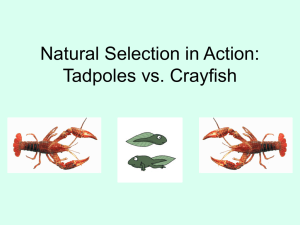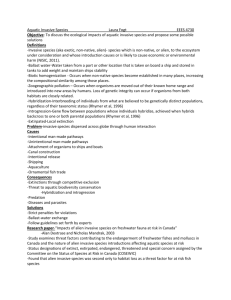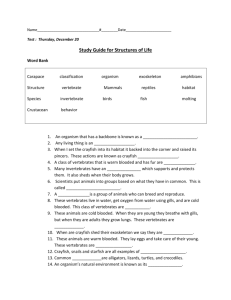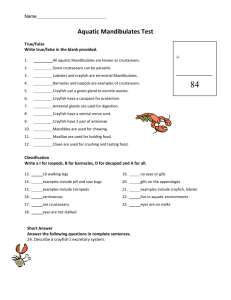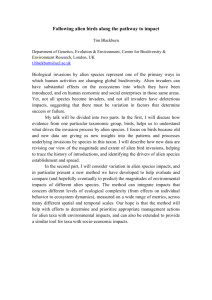(3) Melanie Josefsson Swedish Environmental Protection Agency
advertisement
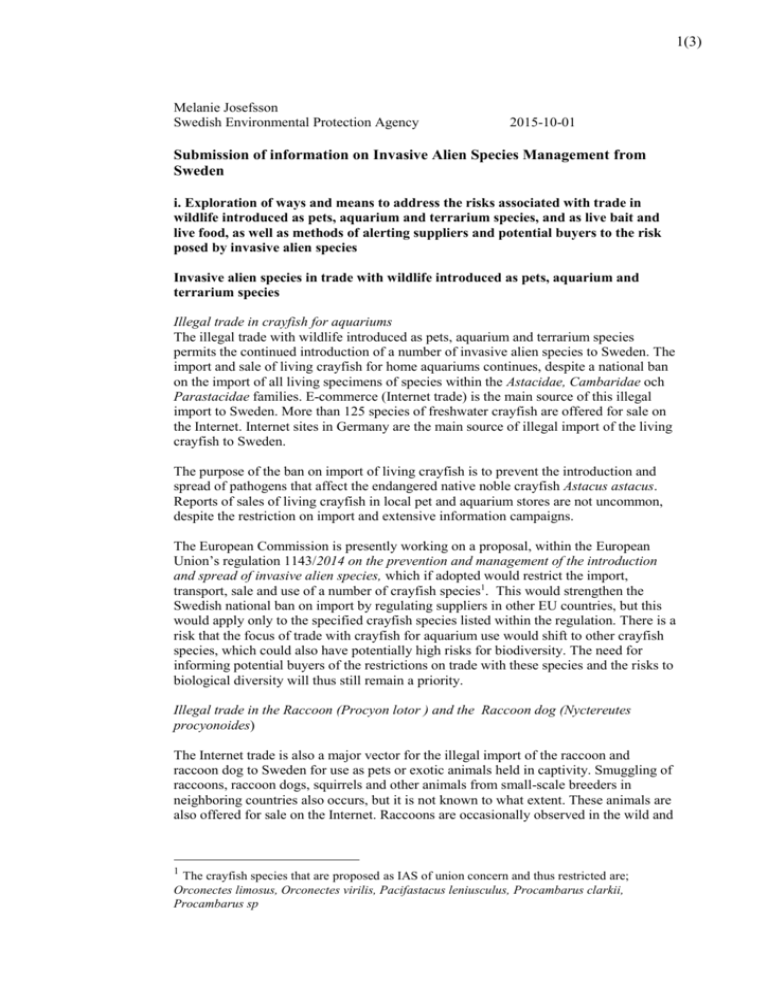
1(3) Melanie Josefsson Swedish Environmental Protection Agency 2015-10-01 Submission of information on Invasive Alien Species Management from Sweden i. Exploration of ways and means to address the risks associated with trade in wildlife introduced as pets, aquarium and terrarium species, and as live bait and live food, as well as methods of alerting suppliers and potential buyers to the risk posed by invasive alien species Invasive alien species in trade with wildlife introduced as pets, aquarium and terrarium species Illegal trade in crayfish for aquariums The illegal trade with wildlife introduced as pets, aquarium and terrarium species permits the continued introduction of a number of invasive alien species to Sweden. The import and sale of living crayfish for home aquariums continues, despite a national ban on the import of all living specimens of species within the Astacidae, Cambaridae och Parastacidae families. E-commerce (Internet trade) is the main source of this illegal import to Sweden. More than 125 species of freshwater crayfish are offered for sale on the Internet. Internet sites in Germany are the main source of illegal import of the living crayfish to Sweden. The purpose of the ban on import of living crayfish is to prevent the introduction and spread of pathogens that affect the endangered native noble crayfish Astacus astacus. Reports of sales of living crayfish in local pet and aquarium stores are not uncommon, despite the restriction on import and extensive information campaigns. The European Commission is presently working on a proposal, within the European Union’s regulation 1143/2014 on the prevention and management of the introduction and spread of invasive alien species, which if adopted would restrict the import, transport, sale and use of a number of crayfish species1. This would strengthen the Swedish national ban on import by regulating suppliers in other EU countries, but this would apply only to the specified crayfish species listed within the regulation. There is a risk that the focus of trade with crayfish for aquarium use would shift to other crayfish species, which could also have potentially high risks for biodiversity. The need for informing potential buyers of the restrictions on trade with these species and the risks to biological diversity will thus still remain a priority. Illegal trade in the Raccoon (Procyon lotor ) and the Raccoon dog (Nyctereutes procyonoides) The Internet trade is also a major vector for the illegal import of the raccoon and raccoon dog to Sweden for use as pets or exotic animals held in captivity. Smuggling of raccoons, raccoon dogs, squirrels and other animals from small-scale breeders in neighboring countries also occurs, but it is not known to what extent. These animals are also offered for sale on the Internet. Raccoons are occasionally observed in the wild and 1 The crayfish species that are proposed as IAS of union concern and thus restricted are; Orconectes limosus, Orconectes virilis, Pacifastacus leniusculus, Procambarus clarkii, Procambarus sp 2(3) captured. They are not escapees from zoos, as these animals are required to be microchipped. They are most probably escaped or released pets that are held illegally. The trade and illegal movement of animals to be used as pets into the country poses a great risk for biodiversity as well as for animal and human health. Sweden is a rabies free country and pets are not required to be vaccinated. The risk for the introduction and spread of rabies by these illegal movements into Swedish wildlife and pets would have great negative consequences for biodiversity, health and socioeconomic values. The raccoon and raccoon dog are also very adaptable predators. The establishment of these animals is a great threat to Swedish birdlife, especially ground nesting birds, and amphibians. Decision support tools used Work with dealing with the illegal trade and Internet trade with wildlife for pets is hampered by the lack of resources, guidance and methods for monitoring the Internet as well as a structured approach for crossboundary cooperation in controlling the trade and movement of animals. In Scandinavia, this trade is, as far as we know, relatively smallscale, but nonetheless is a high risk for biodiversity and human and health. Tools and methods are needed for effectively monitoring what animals are offered for sale on the Internet. Guidance and information materials that are directed at a multinational or regional scale to inform buyers and sellers of the risks are needed. Agreements between governments, and regional strategies involving environmental authorities, health authorities and animal health authorities are needed on a regional scale to deal with the problem would enable a more effective control of both the illegal and legal crossboundary trade in invasive alien species. A international labelling system to indicate what animals and plants are safe for biodiversity and relevant guidance on safe handling by both buyers and sellers would aid national authorities in informing of safe behavior in selecting and keeping alien animals and plants. It would be an advantage if this labelling would apply to all alien species that are sold via the Internet (E-commerce), as well as in nurseries and pet and aquarium supply stores Invasive Alien Species in trade with live food Trade with live specimens of the American lobster Homerus americanus is a growing threat to the native lobster species in Sweden and Norway. Escape of the American lobster from temporary storage in marine enclosures may lead to the establishment and spread of this species as well as the transfer of pathogens and parasites to native fauna. New finding in the sea are continuously reported, despite intensive governmental information campaigns about the risks associated with the handling of live H. americanus. Living specimens of H. americanus are handled by importers, fish dealers, restaurants and the public. Therefore, it is not possible to control the fate of individual lobsters. In 2014 nineteen individual of H. americanus were reported in the Gullmar Fjord, Sweden. One female had hybrid eggs. This has also been observed Norway in 2010. The findings in the Gullmar Fjord may lead to the first confirmed, permanent subpopulation in European waters with a risk for natural spreading of the species in Swedish waters. Once the species is established it will be impossible to eradicate. The ecological and environmental risks associated with H. americanus in European waters are primarily hybridization with European lobster, introducing new diseases and parasites and carrying “hitchhiking” animals living on the lobsters (epibionts), competition with native lobsters and crabs and economic risks (primarily to the European lobster fishery). Since H. americanus reach the sea primarily through escapes 3(3) from illegal holdings it is not known how the situation in the future will be regarding new subpopulations in European waters. This makes it difficult to predict future consequences of the introduction of the species. Sweden has proposed a ban of live import of H. americanus to the EU, with support of the European Union’s regulation 1143/2014 on the prevention and management of the introduction and spread of invasive alien species. A ban on import of living American lobster would effectively protect European waters from being invaded by this species. However, the recent situation in Sweden demonstrates the urgency of action. Decision support tools used In the work with assessing the risks of the American lobster, the Great Britain NonNative Risk Assessment template and guidance was used in preparing the risk assessment. This template is a further development of the International Plant Protection Convention’s Pest Risk Assessment. Further development of the risk assessments and guidance is needed in order to assess the potential effects on biological diversity of possible changes in climate. This is essential for assessing future risks.
